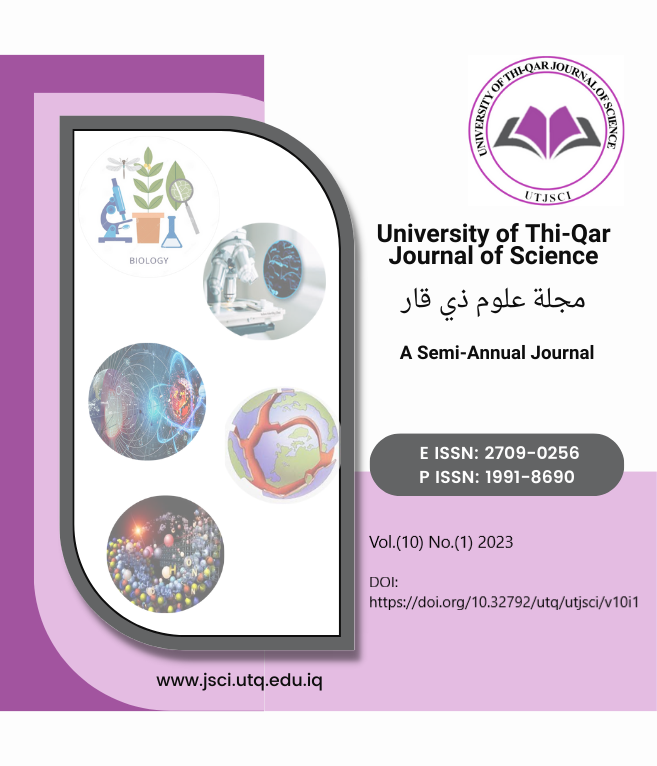Study The Improvement Myco-manufacturing of Crud Bikaverin by Fusarium oxysporum with Evaluation The Antimicrobial Effectiveness
DOI:
https://doi.org/10.32792/utq/utjsci/v10i1.926Keywords:
Optimization, Bikaverin, Toxicity, Fusarium oxysporumAbstract
Bikaverin is a reddish pigment produced by a variety of fungal species, the majority of which belong to the Fusarium genus. This pigment has antibiotic activities against protozoa, bacteria, and fungus. This study investigated the toxicity of Bikaverin to some microbs, production, and characterization of the pigment from the fungus Fusarium oxysporum. The yield of total bikaverin in F. oxysporum shake flask culture was improved by optimizing cultivation variables such as complex medium, carbon supply, nitrogen source, temperature, medium pH, and incubation period. After 10 days and at 28°C in Potato dextrose broth [PDB] supplemented with 2% glucose, 2% corn step liquor, and a pH of 5.5, the maximum production of complete bikaverin was discovered. The isolates of more sensitive bacteria to bikaverin were Staphylococcus aureus and S. typhi, with inhibition zones 24 and 23 mm respectively, at a concentration of 75 μg/mL. The isolates more sensitive bacteria to bikaverin were E. faecalis, E. coli and P. aeruginosa while fungi was C. albicans with inhibition zones of 18, 22, 20 and 13 mm, respectively, at a concentration of 75 μg/mL. The results showed that the toxic antimicrobial activity of bikaverin was clear against fungi and bacteria.
References
2. Asan, A. (1993). The colors produced by Fusarium Link ex Fr.1821 (Deuteromycetes) species in various carbohydrate cultures. I. Fusarium equiseti (Corda) Sacc. 1886, Mikrobiyol Bul. 27: 71-76.
3. Bau, Y.S. and Wong, H.C. (1979). Zinc effect on growth, pigmentation and antibacterial activity of Monascus purpureus. Physiol Plant. 10: 1360-1372.
4. Boonyapranai. K.; Tungpradit, R.; Lhieochaiphant, S. and Phutrakul S. (2008). ptimization of submerged culture for the production of naphthoquinones pigment by Fusarium verticillioides. Chiang Mai J Sci. 35: 457-466.
5. Carels, M. and Shepherd, D. (1977). The effect of different nitrogen sources on pigment production and sporulation of Monascus species in submerged, shaken culture. J Microbiol. 23: 1360-1372.
6. Chen, M.H. and Johns, M.R. (2018). Effect of pH and nitrogen source on pigment production by Monascus purpureus. Appl Microbiol Biotech. 40: 132-138.
7. Demain, A.L. (2016). Regulation of secondary metabolism in fungi. Pure Appl Chem. 58: 219-226.
8. Duarte, M.L.R. and Archer, S.A. (2003). In vitro toxin production by Fusarium solani. Fitopatol Bras. 28: 229- 235.
9. Fogarty, R.V. and Tobin, J.M. (2019). Fungal melanins and their interactions with metals. Enz Microb Technol. 19: 311-317.
10. Kamijo M, Suzuki T, Kawai K, Fujii T, Murase H. (1999). Ytterbium-decreasing Streptomyces sp, and its naphthoquinone pigment production in the presence of rare earth elements. J Biosci Bioengi, 1999; 87: 340-343.
11. Premalatha B., Stanly Pradeep F., Pradeep B. V. and Palaniswamy, M., (2012). Production and characterization of naphthoquinone pigment from Fusarium moniliforme MTCC6985. World Journal of Pharmaceutical research. 1(4): 1126-1142.
12. Marcela Colombo dos Santos, Mayra de Lima Mendonça and Juliano Lemos Bicas. (2020). Modeling bikaverin production by F. oxysporum CCT7620 in shake flask cultures. Bioresource and Bioprocess. 7(13):2-8.
13. Ahmed, E.F. (2015). Antimicrobial and antibiofilm activity of mango seeds extract. Iraqi J Sci. 56(4B): 3121-3129.
14. Obeidat, M.; Shatnawi, M.; Al-alawi, M.; Al-Zubi, E.; Al-Dmoor, H.; Al-Qudah, M.; El-Qudah, J. and Otri, I. (2012). Antimicrobial Activity of Crude Extracts of Some Plant Leaves. Resear J Microbiol. 7: 59-67.
15. Boonyapranai, K., Rudeewan Tungpradit, Sorasak Lhieochaiphant and Suree Phutrakul. (2008). Optimization of Submerged Culture for the Production of Naphthoquinones Pigment by Fusarium verticillioides. Chiang Mai J. Sci. 35(3): 457-466.
16. Rodriguez-Ortiz R, Mehta BJ, Avalos J, Limón MC (2010). Stimulation of bikaverin production by sucrose and by salt starvation in F. fujikuroi. Appl Microbiol Biotechnol 85:1991–2000.
17. Yolmeh M, Habibi Najafi MB, Farhoosh R (2014). Optimisation of ultrasoundassisted extraction of natural pigment from annatto seeds by response surface methodology (RSM). Food Chem 155:319–324.
18. Srivastava P, Srivastava S, Pathak N (2011). Identification of limiting factors for the optimum growth of F. oxysporum in liquid medium. Toxicol. Int 18:111–116.
19. Muhammad, H. and Muhammad, S. (2005). The used of Lawsonia inermis Linn. (Henna) in the management of burn wound infections. Afr. J Biotechnol. 4(9):934-937.
20. M. Carmen Limón & Roberto Rodríguez-Ortiz &Javier Avalos. (2010). Bikaverin production and applications. Appl Microbiol Biotechnol. 87:21–29.
Downloads
Published
License
Copyright (c) 2023 University of Thi-Qar Journal of Science

This work is licensed under a Creative Commons Attribution 4.0 International License.













